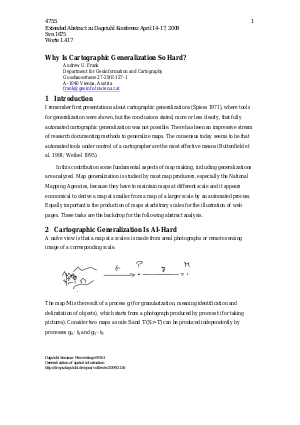Why Is Cartographic Generalization So Hard?
Author Andrew U. Frank
-
Part of:
Volume:
Dagstuhl Seminar Proceedings, Volume 9161
Part of: Series: Dagstuhl Seminar Proceedings (DagSemProc) - License:
 Creative Commons Attribution 4.0 International license
Creative Commons Attribution 4.0 International license
- Publication Date: 2009-09-21
File

PDF
DagSemProc.09161.7.pdf
- Filesize: 47 kB
- 5 pages
Document Identifiers
Subject Classification
Keywords
- Cartographic Generalization
- AI-Hard
- NP-Hard
Metrics
- Access Statistics
-
Total Accesses (updated on a weekly basis)
0Document
0Metadata
Abstract
I remember first presentations about cartographic generalizations (Spiess 1971), where tools for generalization were shown, but the conclusions stated, more or less clearly, that fully automated cartographic generalization was not possible. There has been an impressive stream of research documenting methods to generalize maps. The consensus today seems to be that automated tools under control of a cartographer are the most effective means (Buttenfield et al. 1991; Weibel 1995). In this contribution some fundamental aspects of map making, including generalizations are analyzed. Map generalization is studied by most map producers, especially the National Mapping Agencies, because they have to maintain maps at different scale and it appears economical to derive a map at smaller from a map of a larger scale by an automated process. Equally important is the production of maps at arbitrary scales for the illustration of web pages. These tasks are the backdrop for the following abstract analysis.
Cite As Get BibTex
Andrew U. Frank. Why Is Cartographic Generalization So Hard?. In Generalization of spatial information. Dagstuhl Seminar Proceedings, Volume 9161, pp. 1-5, Schloss Dagstuhl – Leibniz-Zentrum für Informatik (2009)
https://doi.org/10.4230/DagSemProc.09161.7
BibTex
@InProceedings{frank:DagSemProc.09161.7,
author = {Frank, Andrew U.},
title = {{Why Is Cartographic Generalization So Hard?}},
booktitle = {Generalization of spatial information},
pages = {1--5},
series = {Dagstuhl Seminar Proceedings (DagSemProc)},
ISSN = {1862-4405},
year = {2009},
volume = {9161},
editor = {S\'{e}bastien Musti\`{e}re and Monika Sester and Frank van Harmelen and Peter van Oosterom},
publisher = {Schloss Dagstuhl -- Leibniz-Zentrum f{\"u}r Informatik},
address = {Dagstuhl, Germany},
URL = {https://drops.dagstuhl.de/entities/document/10.4230/DagSemProc.09161.7},
URN = {urn:nbn:de:0030-drops-21363},
doi = {10.4230/DagSemProc.09161.7},
annote = {Keywords: Cartographic Generalization, AI-Hard, NP-Hard}
}
